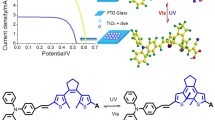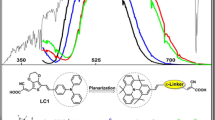Abstract
Donor-π-acceptor (D-π-A) organic compounds have drawn keen interests as photosensitizers in dye sensitized solar cells (DSSCs). Recent studies showed that pyridine ring as an electron-withdrawing anchoring group could lead to efficient electron injection. To improve the performance of pyridine containing sensitizers based DSSCs, the electron donor, π-bridge and the whole structure should be well engineered at molecular level. In this work, we prepared two monomer type dithiafulvene based sensitizers both with a pyridine acceptor but differing in the phenyl-thienyl (DTFPy3) and thienyl-phenyl π-bridges (DTFPy4), and two corresponding dimeric congeners D-DTFPy3 and D-DTFPy4, and tested them in DSSCs. It was found that the arrangement of the electron-rich thienyl group adjacent to the electron donor moiety in the π-bridge red-shifted in the absorption, and the dimeric sensitizers exhibited significantly enhanced absorption. Among them, D-DTFPy4 garnered the highest light harvesting efficiency, yielding an overall power conversion efficiency up to 5.26%.
摘要
近年来, 具有给体-π桥-受体结构的有机化合物作为光敏剂用于染料敏化太阳电池的研究引起广泛关注. 研究发现吡啶作为电子受体和吸附基团时可实现有效的电子注入. 为了提高含吡啶受体有机敏化剂的性能, 需要通过分子工程对电子给体, π桥和分子结构在分子层面上进行优化. 本研究以二硫富瓦烯为电子给体, 吡啶为电子受体, 合成了两个π桥结构分别为噻吩-苯和苯-噻吩的单体型敏化剂DTFPy3和DTFPy4, 对二者及其对应的二聚体型敏化剂D-DTFPy3和D-DTFPy4的研究发现, 调整π桥上富电子噻吩靠近给体一端时可使敏化剂的吸收波长红移. 另外, 二聚体型敏化剂可有效提高敏化剂的吸光强度. 在这四个敏化剂中, D-DTFPy4表现出最佳的光捕获效率, 以其制备的染料敏化太阳电池, 光电转换效率可达5.26%.
Similar content being viewed by others
References
O'Regan B, Grätzel M. A low-cost, high-efficiency solar cell based on dye-sensitized colloidal TiO2 films. Nature, 1991, 353: 737–740
Grätzel M. Mesoscopic solar cells for electricity and hydrogen production from sunlight. Chem Lett, 2005, 34: 8–13
Li B, Wang L, Kang B, et al. Review of recent progress in solid-state dye-sensitized solar cells. Solar Energy Mater Solar Cells, 2006, 90: 549–573
Zhao Z, Liu G, Li B, et al. Dye-sensitized solar cells based on hierarchically structured porous TiO2 filled with nanoparticles. J Mater Chem A, 2015, 3: 11320–11329
Snaith HJ, Schmidt-Mende L. Advances in liquid-electrolyte and solid-state dye-sensitized solar cells. Adv Mater, 2007, 19: 3187–3200
Zhu K, Neale NR, Miedaner A, et al. Enhanced charge-collection efficiencies and light scattering in dye-sensitized solar cells using oriented TiO2 nanotubes arrays. Nano Lett, 2007, 7: 69–74
Zheng X, Wei Z, Chen H, et al. In-situ fabrication of dual porous titanium dioxide films as anode for carbon cathode based perovskite solar cell. J Energy Chem, 2015, 24: 736–743
Ning Z, Tian H. Triarylamine: a promising core unit for efficient photovoltaic materials. Chem Commun, 2009, 5483
Mishra A, Fischer MKR, Bäuerle P. Metal-free organic dyes for dye-sensitized solar cells: from structure: property relationships to design rules. Angew Chem Int Ed, 2009, 48: 2474–2499
Hagfeldt A, Boschloo G, Sun L, et al. Dye-sensitized solar cells. Chem Rev, 2010, 110: 6595–6663
Yella A, Lee HW, Tsao HN, et al. Porphyrin-sensitized solar cells with cobalt (II/III)-based redox electrolyte exceed 12 percent efficiency. Science, 2011, 334: 629–634
Qiu Y, Leung SF, Zhang Q, et al. Nanobowl optical concentrator for efficient light trapping and high-performance organic photovoltaics. Sci Bull, 2015, 60: 109–115
Qiu Y, Chen W, Yang S. Double-layered photoanodes from variable-size anatase TiO2 nanospindles: a candidate for high-efficiency dye-sensitized solar cells. Angew Chim Int Ed, 2010, 49: 3675–3679
Yan K, Qiu Y, Chen W, et al. A double layered photoanode made of highly crystalline TiO2 nanooctahedra and agglutinated mesoporous TiO2 microspheres for high efficiency dye sensitized solar cells. Energy Environ Sci, 2011, 4: 2168–2176
Liu T, Hou J, Wang B, et al. Correlation between the in-plain substrate strain and electrocatalytic activity of strontium ruthenate thin films in dye-sensitized solar cells. J Mater Chem A, 2016, 4: 10794–10800
Shen T, Tian J, Li B, et al. Ultrathin ALD coating on TiO2 photoanodes with enhanced quantum dot loading and charge collection in quantum dots sensitized solar cells. Sci China Mater, 2016, 59: 817–826
Huo Z, Li T, Dai S, et al. Quasi-solid-state dye sensitized solar cells using supramolecular gel electrolyte formed from two-component low molecular mass organogelators. Sci China Mater, 2015, 58: 447–454
Cheng J, Zhang F, Li K, et al. A planar dithiafulvene based sensitizer forming J-aggregates on TiO2 photoanode to enhance the performance of dye-sensitized solar cells. Dyes Pigments, 2017, 136: 97–103
Koumura N, Wang ZS, Mori S, et al. Alkyl-functionalized organic dyes for efficient molecular photovoltaics. J Am Chem Soc, 2006, 128: 14256–14257
Imahori H, Umeyama T, Ito S. Large π-aromatic molecules as potential sensitizers for highly efficient dye-sensitized solar cells. Acc Chem Res, 2009, 42: 1809–1818
Ito S, Miura H, Uchida S, et al. High-conversion-efficiency organic dye-sensitized solar cells with a novel indoline dye. Chem Commun, 2008, 5194
Zhang G, Bala H, Cheng Y, et al. High efficiency and stable dyesensitized solar cells with an organic chromophore featuring a binary π-conjugated spacer. Chem Commun, 2009, 2198
Feldt SM, Gibson EA, Gabrielsson E, et al. Design of organic dyes and cobalt polypyridine redox mediators for high-efficiency dyesensitized solar cells. J Am Chem Soc, 2010, 132: 16714–16724
Zeng W, Cao Y, Bai Y, et al. Efficient dye-sensitized solar cells with an organic photosensitizer featuring orderly conjugated ethylenedioxythiophene and dithienosilole blocks. Chem Mater, 2010, 22: 1915–1925
Cai N, Moon SJ, Cevey-Ha L, et al. An organic D-π-Adye for record efficiency solid-state sensitized heterojunction solar cells. Nano Lett, 2011, 11: 1452–1456
Choi H, Shin M, Song K, et al. The impact of an indeno[ 1, 2-b]thiophene spacer on dye-sensitized solar cell performances of cyclic thiourea functionalized organic sensitizers. J Mater Chem A, 2014, 2: 12931–12939
Liu B, Wang B, Wang R, et al. Influence of conjugated π-linker in D–D–π–A indoline dyes: towards long-term stable and efficient dye-sensitized solar cells with high photovoltage. J Mater Chem A, 2014, 2: 804–812
Yao Z, Zhang M, Wu H, et al. Donor/acceptor indenoperylene dye for highly efficient organic dye-sensitized solar cells. J Am Chem Soc, 2015, 137: 3799–3802
Lee W, Yuk SB, Choi J, et al. The effects of the number of anchoring groups and N-substitution on the performance of phenoxazine dyes in dye-sensitized solar cells. Dyes Pigments, 2014, 102: 13–21
Kim WR, Park H, Choi WY. Conical islands of TiO2 nanotube arrays in the photoelectrode of dye-sensitized solar cells. Nanoscale Res Lett, 2015, 10: 63
Zhang L, Cole JM. Anchoring groups for dye-sensitized solar cells. ACS Appl Mater Interf, 2015, 7: 3427–3455
Wei T, Sun X, Li X, et al. Systematic investigations on the roles of the electron acceptor and neighboring ethynylene moiety in porphyrins for dye-sensitized solar cells. ACS Appl Mater Interf, 2015, 7: 21956–21965
Chitpakdee C, Namuangruk S, Suttisintong K, et al. Effects of π-linker, anchoring group and capped carbazole at meso-substituted zinc-porphyrins on conversion efficiency of DSSCs. Dyes Pigments, 2015, 118: 64–75
Yang L, Yao Z, Liu J, et al. A systematic study on the influence of electron-acceptors in phenanthrocarbazole dye-sensitized solar cells. ACS Appl Mater Interf, 2016, 8: 9839–9848
Ooyama Y, Inoue S, Nagano T, et al. Dye-sensitized solar cells based on donor-acceptor π-conjugated fluorescent dyeswith a pyridine ring as an electron-withdrawing anchoring group. Angew Chem Int Ed, 2011, 50: 7429–7433
Ooyama Y, Nagano T, Inoue S, et al. Dye-sensitized solar cells based on donor-π-acceptor fluorescent dyes with a pyridine ring as an electron-withdrawing-injecting anchoring group. Chem Eur J, 2011, 17: 14837–14843
Daphnomili D, Landrou G, Prakash Singh S, et al. Photophysical, electrochemical and photovoltaic properties of dye sensitized solar cells using a series of pyridyl functionalized porphyrin dyes. RSC Adv, 2012, 2: 12899–12908
Mao J, Wang D, Liu SH, et al. Dye-sensitized solar cells based on functionally separated D-π-Adyeswith 2-cyanopyridine as an electron-accepting and anchoring group. Asian J Organic Chem, 2014, 3: 153–160
Wang L, Yang X, Li S, et al. A new type of organic sensitizers with pyridine-N-oxide as the anchoring group for dye-sensitized solar cells. RSC Adv, 2013, 3: 13677
Lu J, Xu X, Li Z, et al. Zinc porphyrins with a pyridine-ring-anchoring group for dye-sensitized solar cells. Chem Asian J, 2013, 8: 956–962
Ooyama Y, Yamaguchi N, Imae I, et al. Dye-sensitized solar cells based on D–π–A fluorescent dyes with two pyridyl groups as an electron-withdrawing–injecting anchoring group. Chem Commun, 2013, 49: 2548–2550
Bai Y, Zhang J, Zhou D, et al. Engineering organic sensitizers for iodine-free dye-sensitized solar cells: red-shifted current response concomitant with attenuated charge recombination. J Am Chem Soc, 2011, 133: 11442–11445
Cao D, Peng J, Hong Y, et al. Enhanced performance of the dye-sensitized solar cells with phenothiazine-based dyes containing double D−A branches. Org Lett, 2011, 13: 1610–1613
Hong Y, Liao JY, Cao D, et al. Organic dye bearing asymmetric double donor-π-acceptor chains for dye-sensitized solar cells. J Org Chem, 2011, 76: 8015–8021
Guo K, Yan K, Lu X, et al. Dithiafulvenyl unit as a new donor for high-efficiency dye-sensitized solar cells: synthesis and demonstration of a family ofmetal-free organic sensitizers. Org Lett, 2012, 14: 2214–2217
Author information
Authors and Affiliations
Corresponding authors
Additional information
Kunpeng Guo is currently a professor at Taiyuan University of Technology. He received his BSc degree in chemistry from ShanxiUniversity, and PhD degree in chemistry fromthe Key Laboratory of Photochemical Conversion andOptoelectronic Materials, Technical Institute of Physics and Chemistry, Chinese Academy of Sciences. Then, he joined Prof. Shihe Yang’s group in Hong Kong University of Science and Technology as a postdoctoral researcher (Aug. 2010−Aug. 2012). In 2012, he joined the Research Center of Advanced Materials Science and Technology at Taiyuan University of Technology. His current research interests include organic light-harvesting materials, and organic luminescent materials.
Shihe Yang received his BSc degree in polymer chemistry/physics fromSun Yat-Sen University in China and PhD degree in physical chemistry in 1988 (with the Nobel Laureate Prof. Richard E. Smalley). He did post-doctoral research at Argonne National Laboratory and the University of Toronto (with the Nobel Laureate Prof. John C. Polanyi) before joining the faculty of Hong Kong University of Science and Technology, where he is currently a full professor. His research interests include chemistry and physics of finite systems, clusters, nanomaterials, and energy conversion. He and co-workers made contributions to the understanding and development of cluster science, fullerenes/metallofullerenes, novel nanomaterials chemistry, new generation solar cells, solar fuels, and other energy conversion devices. His current interest is focused on solar energy nanoscience and nanotechnology.
Electronic supplementary material
40843_2016_5119_MOESM1_ESM.pdf
Molecular engineering of dithiafulvene organic sensitizers with pyridine acceptor for high efficiency dye-sensitized solar cells
Rights and permissions
About this article
Cite this article
Cao, Y., Cheng, J., Zhang, F. et al. Molecular engineering of dithiafulvene organic sensitizers with pyridine acceptor for high efficiency dye-sensitized solar cells. Sci. China Mater. 59, 797–806 (2016). https://doi.org/10.1007/s40843-016-5119-1
Received:
Accepted:
Published:
Issue Date:
DOI: https://doi.org/10.1007/s40843-016-5119-1




